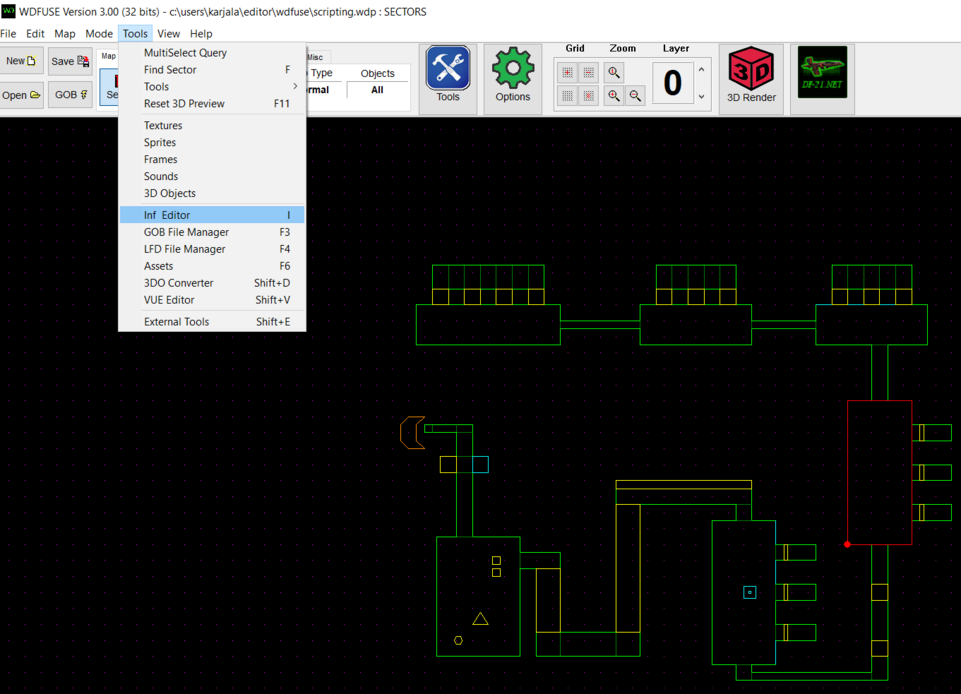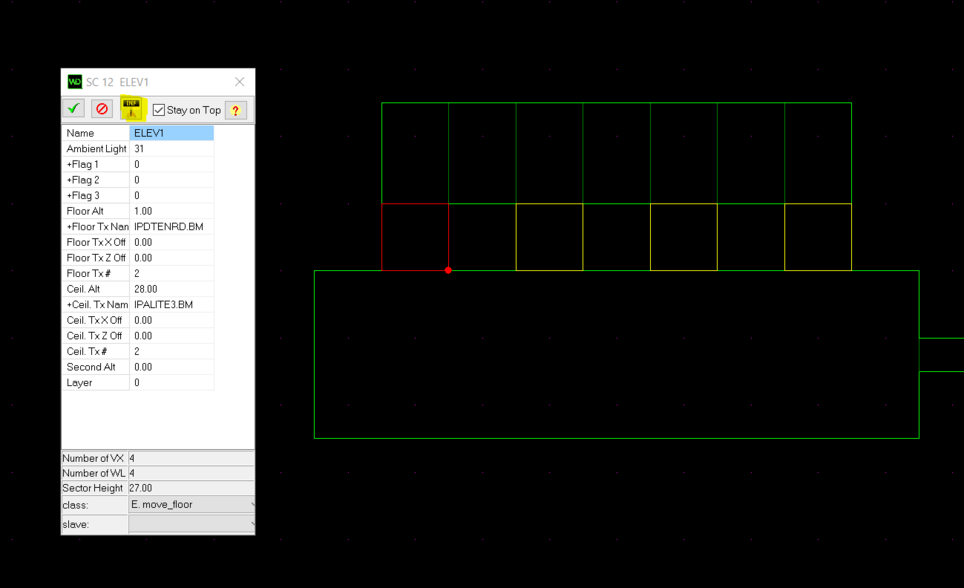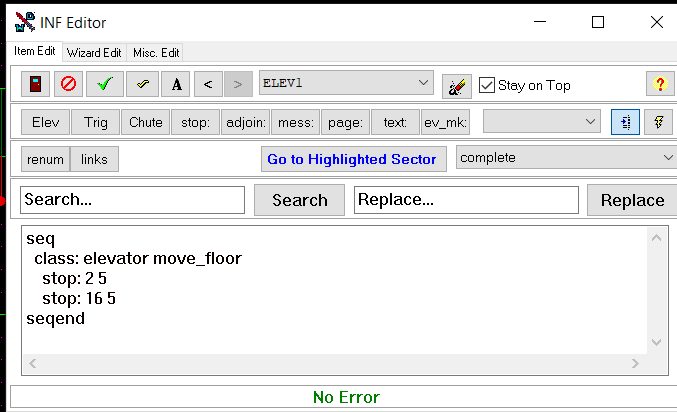INF Scripting
To make your level geometry interactive you would need to learn the INF programming language. Scripts written in INF tell the JEDI engine to control almost every component in the game. From moving elevators, morphing platforms, opening doors, changing lights, moving water and completing objectives, the possibilities for unique adventures in Dark Forces are endless. One can create some amazing and unique experiences not present in the base game.
This tutorial will gradually introduce you to the basic INF concepts. While it helps to understand programming, it is not required as the INF script is more similar to a state machine than modern object-oriented programming. For this section it is critical that you have the community-made INF documentation open as you follow along. Therefore make sure to open this page and keep it handy. It contains Dark Forces component specifications such as GOBs and LFDs but we will be focusing on the INF section.
Important!
While this guide will take things slowly, remember not to get frustrated at the complexity you may encounter. Take your time and be patient, go do something else and come back. The best way to learn is through practice and experimentation!
With that out of the way, go ahead and start a new project and switch to the Scripting tutorial .
INF Editor
All the script editing you will be doing is done in the INF Editor. There are many ways you can bring it up. You can choose it from the main menu or you use the hotkey I.

INF scripts are applied to Sector and Wall components in Dark Forces. Every time you open the Sector or Wall Editors you will see the a small INF icon at the top. By clicking this icon you can also bring up the INF editor. Sectors that have any INF code are colored yellow on the map.

From any Sector or Wall editor you can click the Yellow INF button at the top or press F2 . The hotkey is different from the main map.
Go ahead and click on the sector named ELEV1 and then open the INF editor for that sector using any of the methods described above.

Here you will see a rather complicated window but we will concentrate on only a few components here. The main one is the Script Text Editing Area at the bottom. This is where you will write all your INF scripting code. When you're asked to edit or write something you will go to that text area and make changes. Just like the other windows at the top is the green check mark box. When you are done editing, press it to commit and save your changes. One important difference with the other editors is you cannot autocommit your work as it is very easy to make a mistake and break everything.
Above the text area you can Search and Replace text. This is useful if you have a very large script. At the bottom you will see a small No Error bar. If you make a syntax mistake this will turn red and warn you about an error. The line in your INF code that has an issue will be highlighted.
Center top you will see the name of the INF code titled ELEV1. Every sector that has INF logic applied to it must have a name. To the left of the sector name you will be able to Change your Font button. And to the left of that is a useful checkmark button that Verifies Syntax. Click it if you want to make sure nothing is broken but you don't want to commit your changes. You can also rollback your changes and exit the editor. To the right is the useful "Stay on Top" button. The blue "Go to Highlighted Sector" button is useful to jump to a sector that is referenced in your code. There are many more components here but this is enough to get started.
INF Structure
Lets look at the code in detail. Take your time to understand everything shown.
seq
class: elevator move_floor
stop: 2 5
stop: 16 5
seqend
Every INF script begins with the word SEQ (for Sequence) and ends with the word SEQEND. If you do not have these at the beginning and end your code will not work and you will get errors. Inside the sequence there can be one or more Classes. The Classes are major sequences components that tell the JEDI engine what type of action this sector must take. For a full list of Class Elevators please refer to the DF Specs page .
Class Elevators
All classes in the game are made out of Elevators. In fact, almost every kind of game logic in the game is done with an elevator. That's how Dark Forces keeps track of the level state and makes things interactive. Elevators make sectors and walls dynamic. They can obviously be used to create lifts, platforms, doors etc., but you often also need dummy (i.e. non-accessible) elevators for level control purposes.
Elevators will usually have Stops, which are different values the elevator can arrive at. In the example above, the elevator has two stops.
Class Stops
A Stop is a value that an elevator can arrive at. This value varies depending on the class of elevator, and can be floor altitude, ceiling altitude, ambience, degrees etc. Stops can be used practically, such as different heights a lift stops at, or can be used purely for level control as elevators can also send a message, page a sound, or create an adjoin upon arriving at a stop.
Note: Elevators can have any number of stops. If no stops are given, the elevator will start at value 0 and keep increasing its value throughout the entire level. This may be appropriate for an "elevator scroll_floor", but not for an "elevator move_floor" !!!
usage:
| | stop: [value1] [value2] |
The first value can be given in three ways:
[num] absolute stop
| @[num] relative stop | [sectorname] equal the value of the sector [sectorname] |
The second value can be given in 4 ways:
[time] time in sec that elevator remains at stop
| hold elevator will remain at stop indefinitely | terminate elevator will stay at the stop permanently | complete mission will be complete when elev arrives at stop |
Basic Elevator
Lets see what this ELEV1 sector is doing. Launch the game (GOB) and take a look at the row of elevators in front of you.

Our elevator is on the left and you will see that all it does is automatically move up and down by itself. According to the code (INF Text Area) this elevator has only two stops. For an elevator of type move_floor the stops are the heights at which it will stop. In this case, the first stop is at height 2 and the second one stops at height 16. The second number is the delay (in seconds) at how long this elevator should stay at the stop. In this case, both stops will wait for 5 seconds before going to the next stop. This elevator will go in an infinite loop between these two stops.
From this point on, any time you make a change to the script, make sure you exit the game, save and rerun it to see what has happened. We cannot rely on the 3D renderer as much because it doesn't contain INF logic.
Lets start making our first changes! Just like in real life, an elevator can have multiple stops. Lets add one more stop
seq
class: elevator move_floor
stop: 2 5
stop: 10 1
stop: 16 5
seqend